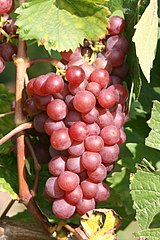Schoenburger
| Schoenburger | |
|---|---|
| Synonyms | no |
| Breeding number | Gm 15-114 |

|
|
| Art | Grape vine ( Vitis vinifera subsp. Vinifera ) |
| Berry color | green |
| use | |
| origin | Germany |
| known since | 1979 |
| breeder | Heinrich Birk , Geisenheim Research Station |
| Breeding year | 1939 |
| VIVC no. | 10833 |
| ancestry | |
|
Cross of |
|
| List of grape varieties | |
Schönburger is a white wine with pink berries. The variety brings floral-spicy wines that are somewhat reminiscent of Traminer .
ancestry
The parents of this cross are Spätburgunder (Pinot noir) and the Pirovano 1 grape , which is hardly known in Germany , which in turn constitutes a cross between red Gutedel (Chasselas rose) and Muscat de Hambourg by the Italian breeder Alberto Piròvano from 1892. Heinrich Birk carried out this new breed in 1939 at the Geisenheim Research Station in the Rheingau . The vine received plant variety protection in 1979 and was entered in the list of varieties a year later . The originally planned name Rosa Muskat was rejected by the Bundessortenamt . The information provided by the breeder about the parents of the cross has been confirmed by DNA analysis in the meantime.
Below the Schönburg in Oberwesel you can find the wine in the vineyard of the Persch winery. When giving the name, Heinrich Birk wanted to draw attention to the fact that wine should be at home in the triangle between the Middle Rhine , Nahe , Palatinate and Rheinhessen . In fact, around 21 hectares are planted with this vine in these areas today.
Ampelographic varietal characteristics
In ampelography , the habitus is described as follows:
- The shoot tip is open. It has thickly woolly to white woolly tomentose hair. The young leaves are only slightly hairy.
- The medium-sized, dark green leaves are five-lobed and indented to a medium depth. The stalk bay is V-shaped, open to closed, but rarely overlapping. The sheet is serrated to a point. The teeth are set medium-wide compared to other grape varieties. The leaf surface (also called blade) is slightly blistered and coarse.
- The cone-shaped grape is small to medium-sized, mostly winged and loose berries. The slightly oval berries are medium-sized and pink in color. The berries have a rough berry skin and have a light nutmeg note in the taste.
The grape variety ripens almost at the same time as the Gutedel and is therefore considered to ripen early in an international comparison. It is a variety of the noble grapevine ( Vitis vinifera ). It has hermaphroditic flowers and is therefore self-fruiting.
The variety is hardly susceptible to powdery mildew , downy mildew and gray mold rot .
distribution
The vineyards in Germany are distributed among the individual growing areas as follows:
| Wine region | Vineyards (hectares) |
|---|---|
| Ahr | - |
| to bathe | - |
| Francs | 1 |
| Hessian mountain road | - |
| Middle Rhine | below 0.5 |
| Moselle | below 0.5 |
| Near | 1 |
| Palatinate | 2 |
| Rheingau | below 0.5 |
| Rheinhessen | 16 |
| Saale-Unstrut | below 0.5 |
| Saxony | below 0.5 |
| Stargarder Land | - |
| Württemberg | below 0.5 |
| Total Germany 2007 | 21st |
Source: Vineyard statistics from March 13, 2008, Federal Statistical Office , Wiesbaden 2008 in Descriptive Variety List of the Federal Variety Office 2008, page 198ff.
The wine is more successful in southern England (Somerset and Kent); here it takes up twice the cultivated area. The vine is also found in Brazil, Italy, Canada and the Czech Republic. The medium-strong growing vine needs sheltered, sunny locations. It is still sufficiently frost-resistant.
Wine
The white wines are flowery and spicy, somewhat reminiscent of Traminer . Associations with "rose scent" and "nutmeg" are also described.
See also
See also the articles Viticulture in Germany , Viticulture in Italy , Viticulture in Brazil , Viticulture in the Czech Republic , Viticulture in Canada and Viticulture in the United Kingdom as well as the list of grape varieties .
Individual evidence
- ↑ Erika Maul, Fritz Schumann, Bernd HE Hill, Frauke Dörner, Heike Bennek, Valérie Laucou, Jean-Michel Boursiquot, Thierry Lacombe, Eva Zyprian, Rudolf Eibach, Reinhard Töpfer: Focus on the crossing parents of German new varieties of vines - what does the genetic fingerprint say. In: German Viticulture Yearbook. Vol. 64, 2013, ISSN 0343-3714 , pp. 128-142.
- ↑ Descriptive list of varieties of the Federal Plant Variety Office 2008 (PDF; 519 kB)
literature
- Pierre Galet : Dictionnaire encyclopédique des cépages. Hachette, Paris 2000, ISBN 2-01-236331-8 .
- Walter Hillebrand, Heinz Lott, Franz Pfaff: Paperback of the grape varieties. 13th, revised edition. Fachverlag Fraund, Mainz 2003, ISBN 3-921156-53-X .
Web links
- Schönburger in the database Vitis International Variety Catalog of the Institute for Vine Breeding Geilweilerhof (English)